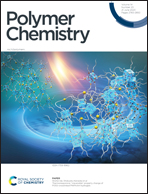Tuning the luminescence of polyacrylonitriles by controlled polymerization†
Abstract
Nonconventional luminescent polymers (NCLPs) have attracted considerable attention due to their unique luminescence behavior. Although various routes can be employed to synthesize such vinyl-based NCLPs, the dependence of their photophysical properties on the polymerization method used and thus potential small variations of the overall macromolecular architecture is rarely reported. In this study, we have investigated in detail the luminescence behavior of polyacrylonitriles (PANs) synthesized with two different polymerization methods, namely, free-radical polymerization (FRP) and reversible addition–fragmentation chain transfer (RAFT). Dependent on the polymerization route and initiator used, PANs show distinct PL and excitation wavelengths, and their emission covers a wavelength range from 400 to 630 nm, respectively. Moreover, the synthesized PANs can be easily homogeneously blended both in solution and solid states, and the resulting emission is a superposition of the emission of the blend components. This study provides a facile approach to tune the photophysical properties of PANs and related vinyl-based NCLPs and provides new fundamental insight into further booster application development of NCLPs.



 Please wait while we load your content...
Please wait while we load your content...